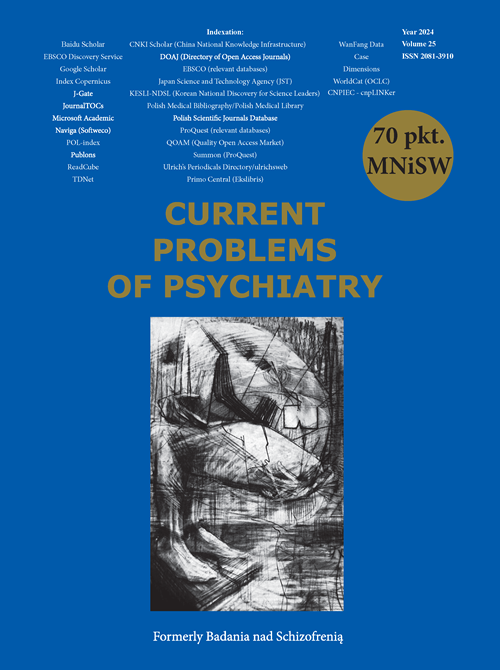Phantom phone signaling (PPS) and mental health - a review
DOI:
https://doi.org/10.12923/2353-8627/2024-0017Słowa kluczowe:
uzależnienie od telefonu komórkowego, fantomowa sygnalizacja telefoniczna (PPS), fantomowy dzwonek (PR), fantomowa wibracja (PV), fantomowe mruganie (PB)Abstrakt
Wstęp: Telefony komórkowe są powszechnie używane na całym świecie, a ich liczbę szacuje się na 7,26 miliarda użytkowników. Zastanawiające jest na ile częstotliwość korzystania z telefonów komórkowych ma wpływ na zdrowie i codzienne życie użytkowników. Istotnymi problemami związanymi z korzystaniem z telefonów komórkowych są dzwonki fantomowe (ang. phantom ringing, PR), wibracje fantomowe (ang. phantom vibration, PV) lub mruganie fantomowe (ang. phantom blinking, PB), które zbiorczo określa się mianem fantomowej sygnalizacji telefonicznej (ang. phantom phone signaling, PPS). Celem poniższego przeglądu systematycznego wg PRISMA było zebranie istniejącej literatury w zakresie fantomowej sygnalizacji telefonicznej PRS i PVS w celu zidentyfikowania potencjalnych nowych obszarów badawczych.
Materiał i metoda: Przeszukiwanie literatury przeprowadzono z wykorzystaniem baz danych Pubmed, Web of Science, Scopus, EBSCO i Google Scholar do 3 marca 2023 roku. Dodatkowe wyszukiwanie przeprowadzono 21 stycznia 2024 roku. Warunki selekcji spełniły 34 artykuły, które zostały przeanalizowane pod kątem aspektów demograficznych oraz psychologicznych.
Dyskusja: Zjawisko PR, PV lub ogólnie PPS jest odwrotnie skorelowane z wiekiem respondentów. Wyniki badań wskazują, że liczba i intensywność odczuwanego PV są związane z miejscem, w którym dana osoba nosi telefon. Edukacyjny lub komunikacyjny cel korzystania z telefonu mają związek z doświadczeniem PPS. Literatura wskazuje także na korelację między uzależnieniem od telefonu a PV, PR i ogólnie PPS oraz związek między depresją i lękiem, a doświadczeniami fantomowymi.
Wnioski: PPS jest zjawiskiem, które wydaje się związane z uzależnieniem. Przyszłe badania warto przeprowadzić na innych, większych grupach badawczych. Dodatkowo można rozważyć przeprowadzenie badań podłużnych.
Bibliografia
1. LeFevre AE, Shah N, Bashingwa JJH, et al. Does women’s mobile phone ownership matter for health? Evidence from 15 countries. BMJ Glob Health. 2020;5(5):e002524. doi:10.1136/bmjgh-2020-002524
2. Deb A. Phantom vibration and phantom ringing among mobile phone users: A systematic review of the literature. Asia-Pac Psychiatry. 2015;7(3):231-9.
3. Rothberg MB, Arora A, Hermann J, et al. Phantom vibration syndrome among medical staff: a cross-sectional survey. BMJ.2010;341:c6914. doi:10.1136/bmj.c6914
4. Olson JA, Sandra DA, Colucci ÉS, Al Bikaii A, Chmoulevitch D, Nahas J, et al. Smartphone addiction is increasing across the world: A meta-analysis of 24 countries. Comput Hum Behav. 2022 April 1;129:107138.
5. Page MJ, McKenzie JE, Bossuyt PM, Boutron I, Hoffmann TC, Mulrow CD, et al. The PRISMA 2020 statement: an updated guideline for reporting systematic reviews. BMJ. 2021 March 29;372:n71.
6. Ortiz de Gortari AB. Empirical study on Game Transfer Phenomena in a location-based augmented reality game. Telemat Inform. 2018 May 1;35(2):382-96.
7. Singh RK, Esht V, Chahal A. Timed Vibration Sense and Joint Position Sense among Male University Students Experiencing Phantom Vibration Syndrome, Affecting Their Lifestyle. J Lifestyle Med. 2022 September 30;12(3):171-7.
8. Setianingrum AY. Hubungan Phantom Vibration Syndrome Terhadap Sleep Disorder dan Kondisi Stress. J Optimasi Sist Ind. 2017 Oct 8;16(2):158-66.
9. Iqra PN. Phantom Vibration Syndrome Dan Penanganannya (Studi Kasus Pada 1 Mahasiswa Di Universitas Negeri Makassar). 2022 November 4 [cited 2023 April 2]; Available from: http://eprints.unm.ac.id/25320/
10. Lin YH, Chen CY, Li P, et al. A dimensional approach to the phantom vibration and ringing syndrome during medical internship. J Psychiatr Res. 2013;47(9):1254-1258. doi:10.1016/j.jpsychires.2013.05.023
11. Lin YH, Lin KI, Pan YC, et al. Investigation of the Role of Anxiety and Depression on the Formation of Phantom Vibration and Ringing Syndrome Caused by Working Stress during Medical Internship. Int J Environ Res Public Health. 2020;17(20):7480. doi:10.3390/ijerph17207480
12. Lin YH, Lin SH, Li P, et al. Prevalent Hallucinations during Medical Internships: Phantom Vibration and Ringing Syndromes. PLOS ONE. 2013;8(6):e65152. doi:10.1371/journal.pone.0065152
13. Chen CP, Wu CC, Chang LR, et al. Possible association between phantom vibration syndrome and occupational burnout. Neuropsychiatr Dis Treat. 2014;10:2307-2314. doi:10.2147/NDT.S73038
14. Goyal AK. Studies on Phantom Vibration and Ringing Syndrome among Postgraduate Students. Indian J Community Health. 2015 Jan 1;27(1):35-40.
15. Sauer VJ, Eimler SC, Maafi S, et al. The phantom in my pocket: Determinants of phantom phone sensations. Mob Media Commun. 2015;3(3):293-316. doi:10.1177/2050157914562656
16. Tanis M, Beukeboom CJ, Hartmann T, et al. Phantom phone signals: An investigation into the prevalence and predictors of imagined cell phone signals. Comput Hum Behav. 2015;51:356-362. doi:10.1016/j.chb.2015.04.039
17. Al-Ani GTS, Mohammed NH, Hassan AE. Evaluation of the Sensation of Hearing False Mobile Sounds (Phantom Ring Tone; Ringxiety) in Individuals. Iraqi Postgrad Med J. 2009;8(1):90-4.
18. Drouin M, Kaiser DH, Miller DA. Phantom vibrations among undergraduates: Prevalence and associated psychological characteristics. Comput Hum Behav. 2012 Jul 1;28(4):1490-6.
19. Subba SH, Mandelia C, Pathak V, Reddy D, Goel A, Tayal A, et al. Ringxiety and the Mobile Phone Usage Pattern among the Students of a Medical College in South India. J Clin Diagn Res JCDR. 2013 Feb;7(2):205-9.
20. Alam M, Qureshi MS, Sarwat A, Haque Z, Masroor MS, Makki MA, et al. Prevalence of Phantom Vibration Syndrome and Phantom Ringing Syndrome (Ringxiety): Risk of Sleep Disorders and Infertility among Medical Students. Int J Adv Res. 2014;2(12):688-93.
21. Gupta N, Garg S, Arora K. Pattern of mobile phone usage and its effects on psychological health, sleep, and academic performance in students of a medical university. Natl J Physiol Pharm Pharmacol. 2016;6(2):132.
22. Kruger DJ, Djerf JM. High Ringxiety: Attachment Anxiety Predicts Experiences of Phantom Cell Phone Ringing. Cyberpsychology Behav Soc Netw. 2016 Jan;19(1):56-9.
23. Kruger DJ, Djerf JM. Bad vibrations? Cell phone dependency predicts phantom communication experiences. Comput Hum Behav. 2017 May 1;70:360-4.
24. Ramesh Masthi NR, S Gowda P, Mallekavu P. A Comparative Study On Social Media Addiction Between Public And Private High School Students Of Urban Bengaluru, India. ASEAN J Psychiatry. 2017 December 1;18(2):206-15.
25. Mohammadbeigi A, Mohammadsalehi N, Moshiri E, et al. The prevalence of phantom vibration/ringing syndromes and their related factors in Iranian’ students of medical sciences. Asian J Psychiatry. 2017;27:76-80. doi:10.1016/j.ajp.2017.02.012
26. Ramesh Masthi NR, Pruthvi S, Phaneendra MS. A Comparative Study on Social Media Usage and Health Status among Students Studying in Pre-University Colleges of Urban Bengaluru. Indian J Community Med Off Publ Indian Assoc Prev Soc Med. 2018;43(3):180-4.
27. Mangot AG, Murthy VS, Kshirsagar SV, et al. Prevalence and Pattern of Phantom Ringing and Phantom Vibration among Medical Interns and their Relationship with Smartphone Use and Perceived Stress. Indian J Psychol Med. 2018;40(5):440-445. doi:10.4103/IJPSYM.IJPSYM_141_18
28. Gemeay E, Elsayed Noura, Mansour E, et al. Relation between Phantom Vibration/Ringing Syndromes and Level of Anxiety among Nursing Students. Int J Nov Res Healthc Nurs. 2018;5(3):25-33.
29. Abbas H, Mohammed Q. Association of Phantom Vibration and Ringing Syndrome and Job-Related Stress among Nurses in Al-Nasiriyah City. Iraqi Natl J Nurs Spec. 2018 Dec 14;31(1):84-92.
30. Pisano S, Muratori P, Senese VP, Gorga C, Siciliano M, Carotenuto M, et al. Phantom Phone Signals in youths: Prevalence, correlates, and relation to psychopathology. PLOS ONE. 2019 Jan 4;14(1):e0210095.
31. Dang TN, Hoa NT, Long NP, et al. The prevalence and related factors of phantom vibration among medical students: A first look in Vietnam. MedPharmRes. 2019;3(3):23-31. doi:10.32895/UMP.MPR.3.3.5
32. Choudhury S, Saha I, Som TK, et al. Mobile phone involvement and dependence among undergraduate medical students in a Medical College of West Bengal, India. J Educ Health Promot. 2019;8:1. doi:10.4103/jehp.jehp_134_18
33. Sebastian SR, Saji JA, Salam SA, et al. The phantom syndrome: a descriptive study on prevalence and association with smartphone addiction and perceived stress among medical students in central Kerala. Int J Community Med Public Health. 2020;7(6):2348-2351. doi:10.18203/2394-6040.ijcmph20202497.
34. Srivastava R, Singh N, Swain SR, et al. A Study to Evaluate the Phantom Vibration Syndrome (PVS) and Ringxiety Among Students of Technical Institute. MIT Int J Pharm Sci. 2020;6(1):1-7.
35. Charulatha RJ, R U, B K. Distribution of Phantom Vibration Syndrome and Its Association on Psychological Morbidity among Medical Students, South India. Natl J Community Med. 2021 December 31;12(12):416-20.
36. Aakash Kumar B, Latha R. Nomophobia and the psychophysiological effects of PUBG gaming on medical college student’s health and academic performance. Biomedicine. 2022 Jul 3;42(3):567-73.
37. Lasanthika TLC, Hettiaratchi UPK. Mobile Phone Usage Pattern and Incidence of Self-Reported Health Problems among a Selected Population of University Students in Sri Lanka: A Cross-Sectional Study. Indian J Public Health Res Dev. 2022 Apr 12;13(2):173-82.
38. Riaz U, Perveen S, Afzal M, et al. The Frequency of Phantom Vibration Syndrome in Medical Staff: A Cross Sectional Survey. Pak J Med Health Sci. 2022;16(06):979-979. doi:10.53350/pjmhs22166979.
39. Ramasubramani P, Vengadessin N, Saya GK. Prevalence of Phantom Vibrations and Ringing Syndrome, and its Association with Smartphone Addiction among Medical Students of Teaching Hospital, South India. Psychiatry. 2022 Nov 29;0(0):1-7.
40. Mali T. Prevalence of Tactile Hallucination of Phone Vibration among Individuals Aged 18-22 Years. ASEAN Journal of Psychiatry, Vol. 24 (7) July, 2023; 1-7.
41. Aleksandrowicz A, Kowalski J, Gawęda Ł. Phantom phone signals and other hallucinatory-like experiences: Investigation of similarities and differences. Psychiatry Res. 2023 Jan 1;319:114964.
42. Lin YH, Chang LR, Lee YH, et al. Development and Validation of the Smartphone Addiction Inventory (SPAI). PLOS ONE. 2014;9(6):e98312. doi:10.1371/journal.pone.0098312.
43. Pisano S, Masi G, Catone G, Muratori P, Milone A, Iuliano R, et al. Phantom Phone Signal: why it should be of interest for psychiatry. Riv Psichiatr. 2021 May 1;56(3):138-42.
Pobrania
Opublikowane
Numer
Dział
Licencja
Prawa autorskie (c) 2024 Autorzy

Utwór dostępny jest na licencji Creative Commons Uznanie autorstwa 4.0 Międzynarodowe.


